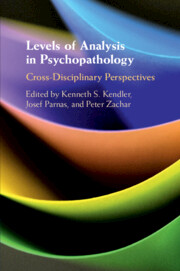Book contents
- Levels of Analysis in Psychopathology
- Advance Praise for Levels of Analysis in Psychopathology
- Levels of Analysis in Psychopathology
- Copyright page
- Contents
- Figures
- Tables
- Contributors
- Preface
- General Introduction
- Part I Neuroscience, Mechanisms, and RDoC
- Section 1
- Section 2
- 4 Introduction
- 5 Wrangling the Matrix: Lessons from the RDoC Working Memory Domain
- 6 Brain and Mind in Psychiatry? Presuppositions of Cognitive Ontology
- Section 3
- Part II Phenomenology, Biological Psychology, and the Mind–Body Problem
- Part III Taxonomy, Integration, and Multiple Levels of Explanation
- Index
4 - Introduction
from Section 2
Published online by Cambridge University Press: 02 April 2020
- Levels of Analysis in Psychopathology
- Advance Praise for Levels of Analysis in Psychopathology
- Levels of Analysis in Psychopathology
- Copyright page
- Contents
- Figures
- Tables
- Contributors
- Preface
- General Introduction
- Part I Neuroscience, Mechanisms, and RDoC
- Section 1
- Section 2
- 4 Introduction
- 5 Wrangling the Matrix: Lessons from the RDoC Working Memory Domain
- 6 Brain and Mind in Psychiatry? Presuppositions of Cognitive Ontology
- Section 3
- Part II Phenomenology, Biological Psychology, and the Mind–Body Problem
- Part III Taxonomy, Integration, and Multiple Levels of Explanation
- Index
Summary
As Bilder makes clear, the birth of RDoC was closely inter-related with growing frustration at the slow pace of etiologic research on the DSM-defined psychiatric disorders. Part of the argument underlying the effort was that these syndromally defined diagnostic categories were at the “wrong level” to propel the needed progress. This should come as no surprise as the charge of the DSM is to develop clinically useful and reliable categories. Given the probable heterogeneity of psychiatric disorders and the massive many-to-many relationships likely between underlying mind/brain dysfunctions and clinical manifestations of psychiatric symptoms and signs, the expectation of a simple single road from DSM categories to etiology is unrealistic. RDoC was based on the assumption that the created matrix, especially the psychological constructs making up the rows, would be a more fruitful focus for etiological research than the DSM categories.
- Type
- Chapter
- Information
- Levels of Analysis in PsychopathologyCross-Disciplinary Perspectives, pp. 57 - 58Publisher: Cambridge University PressPrint publication year: 2020
- 1
- Cited by

